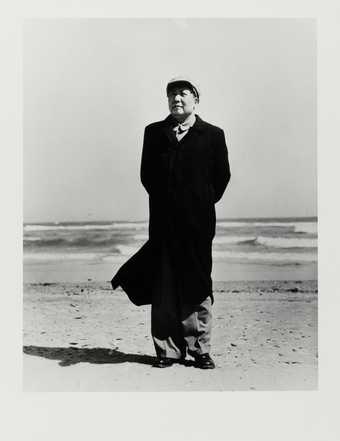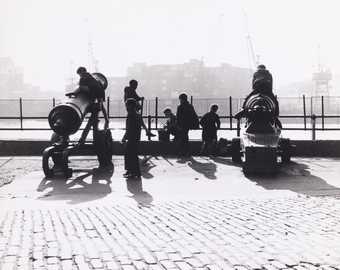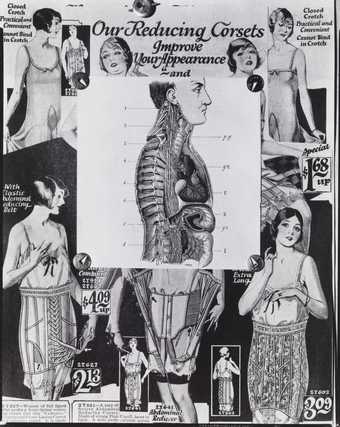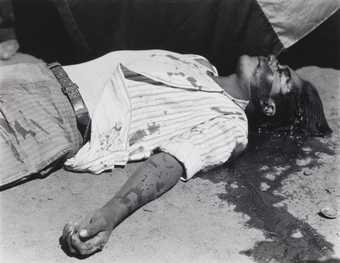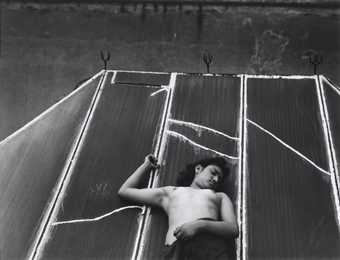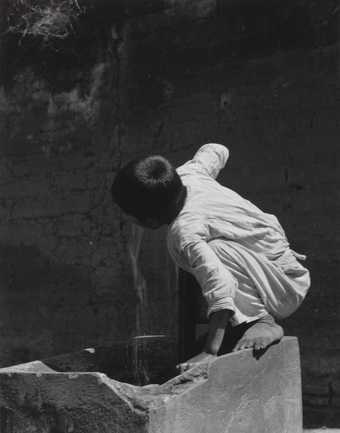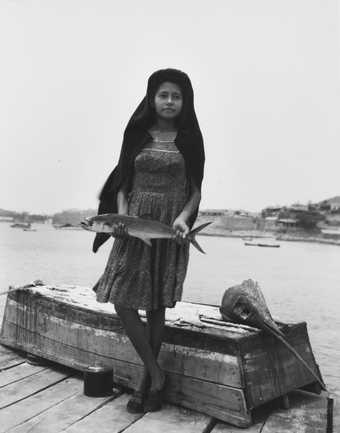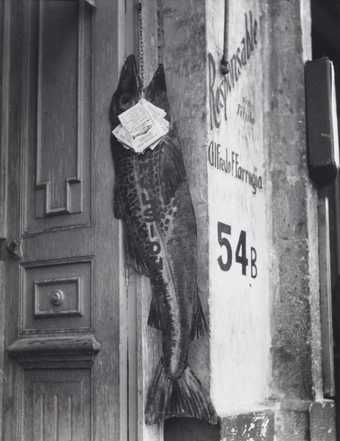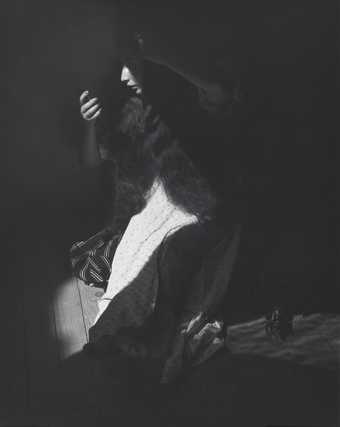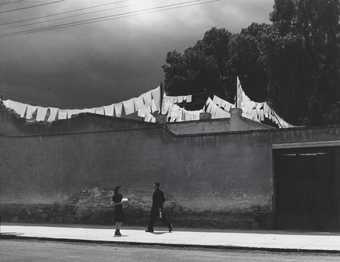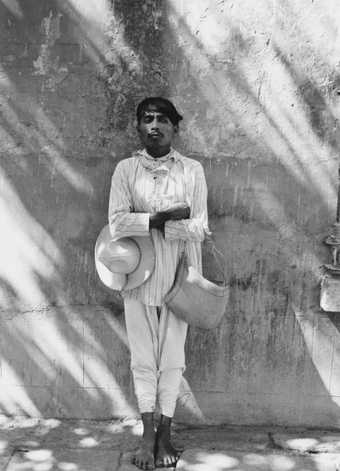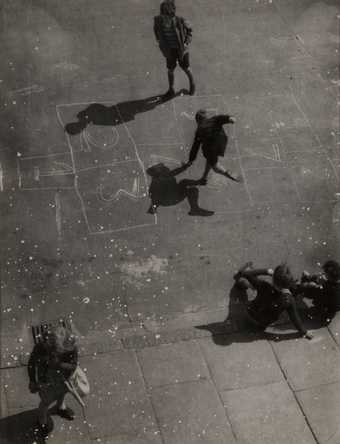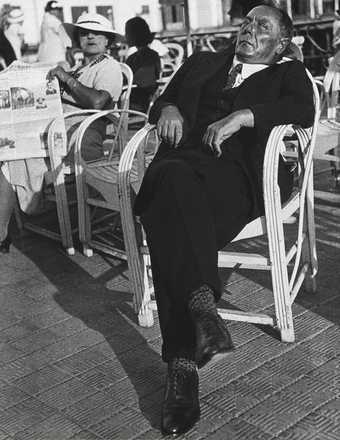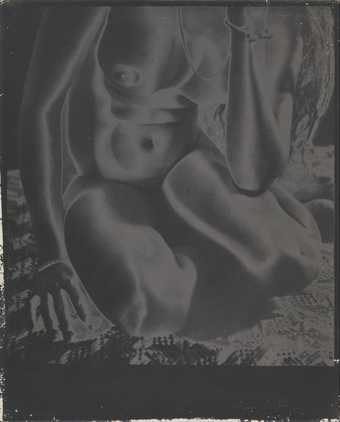
In Tate Britain
Prints and Drawings Room
View by appointment- Artist
- Manuel Álvarez Bravo 1902–2002
- Original title
- Espejo Negro
- Medium
- Photograph, gelatin silver print on paper
- Dimensions
- Unconfirmed: 330 × 255 mm
- Collection
- Tate
- Acquisition
- Accepted by HM Government in lieu of inheritance tax from the Estate of Barbara Lloyd and allocated to Tate 2009
- Reference
- P13111
Summary
Black Mirror 1947 is a medium-size black and white photograph by the Mexican artist Manuel Álvarez Bravo. The photograph depicts an outdoor scene featuring a nude black woman sitting on a piece of fabric and leaning against a smooth blank wall. The woman is shown in full at the centre of the photograph, with her knees drawn up towards her chest so that her right breast and most of her left breast are concealed. She tilts her head towards the top right corner of the image, in the direction of the sunlight that fills the scene and causes shadows to be cast across the right side of her body and the wall and floor to her right. The woman’s left arm is bent, the elbow resting on her left knee, and her hand supports her head’s upward tilt. Her right arm rests upon her other knee, casting a curved shadow on the ground next to her.
Álvarez Bravo made Black Mirror in Mexico in 1947, and the sitter is the American model and dancer Maudelle Bass, who was visiting the country at the time. Álvarez Bravo photographed Bass with a Graflex camera, a large-format, single-lens reflex device that gives the photographer a full view of the ground glass within the camera – upon which the image being photographed is reflected – until the moment of exposure. This allowed Álvarez Bravo to see the proportions and layout of the image much more clearly prior to pressing the shutter than was possible with other cameras available at this time. The size of the negatives used in large-format cameras also allowed the photographer to create a more detailed image than could be achieved with smaller negatives.
Álvarez Bravo titled his photograph Black Mirror in reference to the Aztec deity Tezcatlipoca, a name that translates to English as ‘Smoking Mirror’ (see Museum of Photographic Arts 1990, p.23). The Aztecs, who occupied parts of central Mexico in the thirteenth to the sixteenth centuries, understood Tezcatlipoca to be a god of contradictions – both good and evil, and both prosperous and poor – although he was also associated with a wide range of other meteorological, moral and physical concepts. In Aztec art Tezcatlipoca was usually depicted with a mirror made of obsidian – a kind of volcanic rock that is deep black in tone – that symbolised his ability to see everything that was happening in the world. As well as making reference to the colour of Bass’s skin and its reflective surface in the bright sunlight, the title Black Mirror implies a further significance for her physical qualities, suggesting their connection to a higher spiritual power that is native to the location in which the photograph was taken.
During the 1930s and 1940s Bass modelled for several American and Mexican artists, including Edward Weston, Diego Rivera, Sonia Noskowiak and Carl van Vechten, as well as Álvarez Bravo. Almost all of the paintings and photographs made of Bass during this time show her in poses that suggest self-assurance and sexual empowerment, and the historian Carla Williams has posited that Bass may have been involved in directing the compositions of the works in which she featured. According to Williams, the control that Bass may have exercised over her self-image was part of her wider challenge to visual stereotypes of black women. Williams states that
beginning in the 1930s, through the figuring of her mostly nude body, she enacted and defined a new, modern definition of the black woman that moved beyond the discourse of slavery, sexual degradation and stereotype.
(Williams 2007, p.34.)
Furthermore, Williams argues that one of the most pervasive images of black women in the United States during the 1930s and 1940s was the mammy, ‘a large, dark-skinned, desexualised, loyal caretaker’ (Williams 2007, p.34). In 1939, the actress Hattie McDaniel had won an Oscar for her portrayal of the character Mammy in Gone with the Wind, a film that was also extremely popular in Mexico. Williams argues that through her bold poses, Bass departed from the established ‘notions of sexuality (the neutered versus the sexualised, fair-skinned Jezebel with more European features), class and labour (domestic work)’ (Williams 2007, p.34).
Álvarez Bravo developed his career as an art photographer from the late 1920s onwards, teaching photography at the Escuela Central de Artes Plásticas, Mexico City, in 1938–9, and during the 1940s he worked in the Mexican film industry taking production stills. Curator Susan Kismaric has argued that Álvarez Bravo’s work both addresses ‘the theme of Mexican history, culture and identity’ and explores the ‘conception of photography as a fluid medium of observation, in which episodes of everyday life are distilled by the alert eye of the photographer into emblems, or fables, of experience’ (Kismaric 1997, p.24). These two features are discernible in Black Mirror in its allusion to Aztec spiritual practices and its almost cinematic portrayal of a celebrated model at rest in an intimate pose and setting.
Further reading
Revelaciones: The Art of Manuel Álvarez Bravo, exhibition catalogue, Museum of Photographic Arts, San Diego 1990, p.23, reproduced p.96.
Susan Kismaric (ed.), Manuel Álvarez Bravo, exhibition catalogue, Museum of Modern Art, New York 1997.
Carla Williams, ‘Maudelle Bass: A Model Body’, Nka: Journal of Contemporary African Art, Autumn 2007, pp.34–46.
Michal Goldschmidt
December 2014
Supported by Christie’s.
Does this text contain inaccurate information or language that you feel we should improve or change? We would like to hear from you.
Explore
- leisure and pastimes(3,435)
-
- recreational activities(2,836)
-
- sunbathing(54)
- miscellaneous(732)
-
- cloth(83)
- actions: postures and motions(9,111)
-
- head in hand / hands(278)
- looking up(126)
- sitting(3,347)
- woman(9,110)
- black(796)
- female(1,681)
You might like
-
Hou Bo Chairman Mao Zedong at Beidaihe Hebei Provence
1954, printed later -
Dorothy Bohm Tower of London
c.1960–9 -
Manuel Álvarez Bravo The Sympathetic Nervous System
1929, later print -
Manuel Álvarez Bravo Striking Worker Assassinated
1934, later print -
Manuel Álvarez Bravo Tools
1931, later print -
Manuel Álvarez Bravo Sparrow skylight
1939, later print -
Manuel Álvarez Bravo Public Thirst
1934, later print -
Manuel Álvarez Bravo A Fish Called Sword
1944, later print -
Manuel Álvarez Bravo The Big Fish Eats the Little One
1932, printed c.1980s -
Manuel Álvarez Bravo Portrait of the Eternal
1935, printed c.1980s -
Manuel Álvarez Bravo How Small the World Is
1942, printed c.1960–70s -
Manuel Álvarez Bravo Man from Papantla
1935, later print -
Nigel Henderson Chisenhale Road
1951 -
Lisette Model French gambler, Promenade des Anglais, Riviera
1934, printed 1976 -
Lionel Wendt [title not known]
c.1934–7

